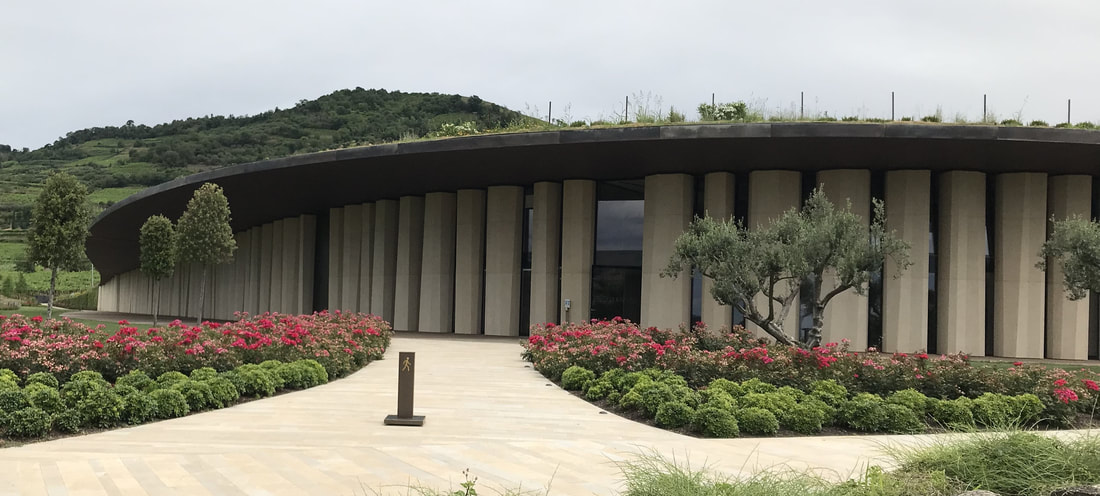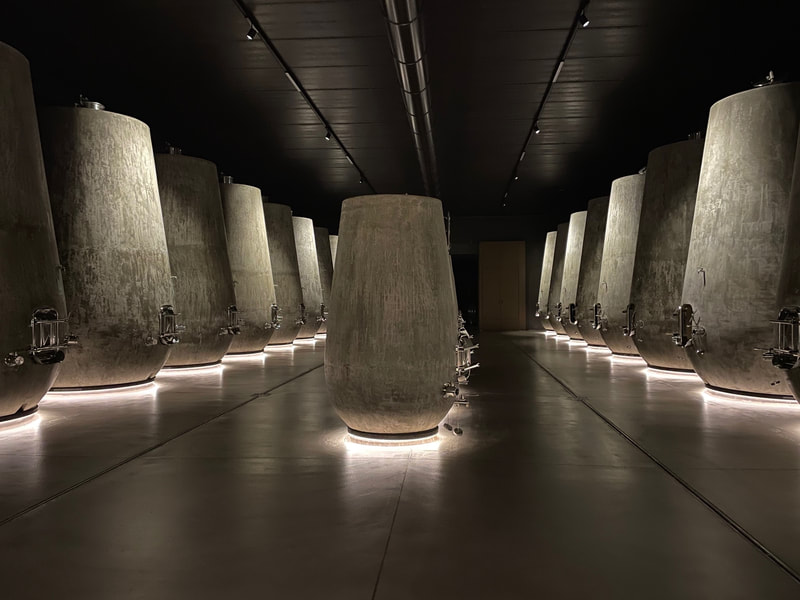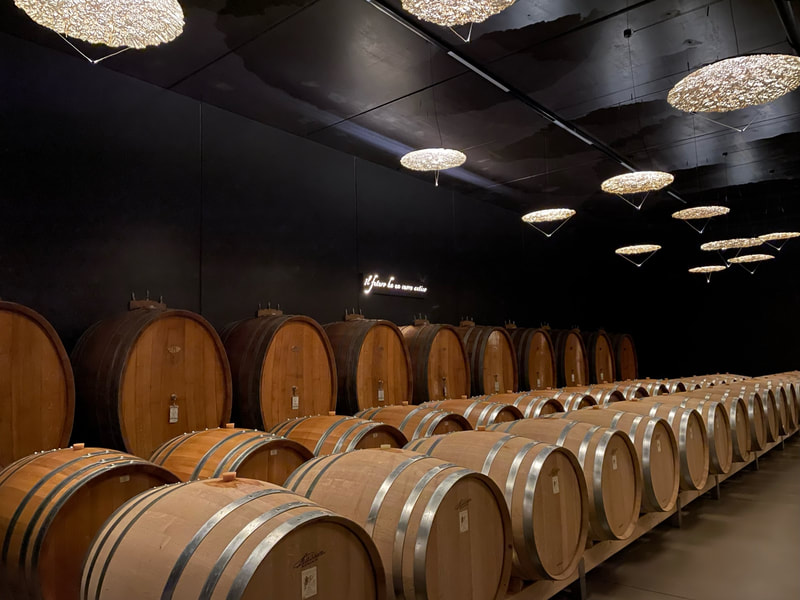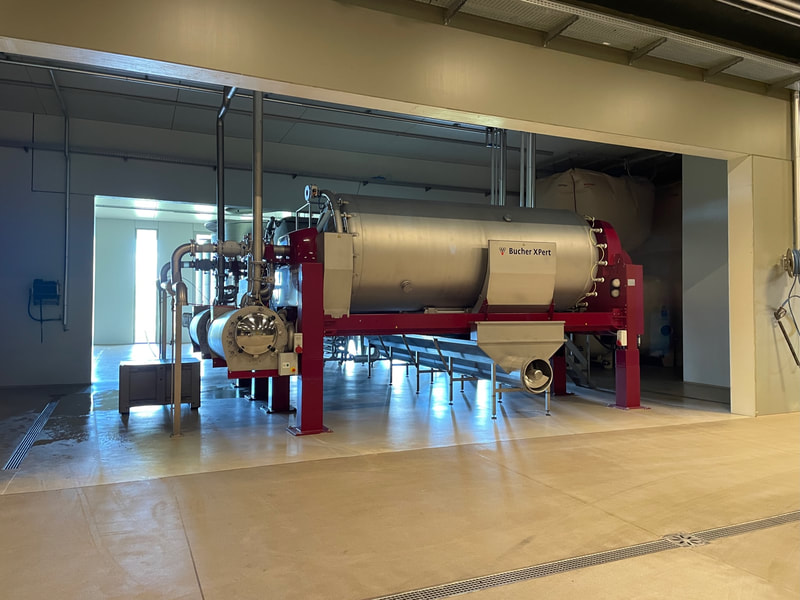Thankfully, we were able to get a reservation for a tour and tasting. As Italy has changed with he pandemic and reservations required for seemingly most everything, we almost missed our chance. My brother and sister-in-law ran to the winery near the close of business the previous day to sweettalk us into a nearly last-minute spots for a visit.
Not far from the autostrada, the next day our van drove through some of the village and then snaking through vineyards to a parking space in front of the winery. Pieropan’s entrance is rather dramatic: numerous irregular tan columns set in front of a lengthy curving portico with a walkway leading to small glass door entrance and the bulk of the winery hid under the rising hilltop that is covered in more vines. I’ve been to a number of wineries, mostly in Italy, and I’ve never seen anything like Pieropan in Soave. Finally finished and opening to the public in April and costing a reported 20 million euros, it takes advantage of current technology, inspired industrial design, beautiful contemporary architecture, a minimalist décor, and a strong sensibility for a low-impact to the environment and sustainability in production.
After an introduction by the entrance, our smallish group was lead through dark gray, mostly unadorned and soaring hallways to the first of the production rooms. That was one of the most striking aspects of the winery’s design was the compartmentalization. Each part of the wine production – crushing, fermentation, aging for each type of Soave, bottling, packaging – seemed to have its own room. Another was the extensive use of nitrogen, which was distributed from a room of its own, too. Pieropan claims to be one of the first to use nitrogen in the bottles, allowing for much less use of sulfites as a preservative, just 30 to 40 grams. Those lower amounts help the wines age much better they believe. Their basic Calvarino bottlings of Soave can easily age fifteen to twenty years.
Large rectangular fermentation tanks fit snuggly against each other with no wasted space in the fermentation room. The aging room for Calvarino initially appeared to be something out of Alien, large almost egg-like cement vessels in two sizes set in three straight rows alighted from below in a largely darkened room. The next chambers, for wood-aged La Rocca wines was nearly as dramatic, featured rows of similar-looking red-banded tonneaux, the French 500-liter barrels, on the floor with a few larger vertical wood tanks visible along the walls, and a pithy phrase shown in neon above some of them. We saw rooms for bottling, for the direct distribution to restaurants in Italy of specially aged bottles, and for bulk distribution that had plenty of space for trucks to be loaded. There was a lot of extra space for substantial expansion. The winery makes around 700,000 bottles of Soave now. The most surprising thing to me was that there are just two production employees, if I heard our guide correctly. That is efficient.
There were several other men in our small group for the tour. Tall and poorly dressed, I assumed that they were German or Dutch. Taking non-touristy photos like the inside of a large fermentation vessel and asking very technical questions, it turned out that they were from a winery in Croatia getting tips and inspiration. There was a lot to learn from this new subterranean palace.
Though each of us was quite impressed with the design and look of the winery, we were mostly there to taste the wines, which did not disappoint after we had moved to a clean-lined conference room that looked out to the expanse of vines. All were beautiful balanced, fruity enough and noticeable acidity and a certain depth of flavor. Pieropan’s wines are made only with organic grapes if selected yeasts. From the base Soave Classico, crisp and tasty and a very welcome aperitif, especially on a warm day. The Calvarino Soave that is aged in the glass-lined cement tanks was my favorite, with a pronounced minerality, a salinity, and a long taste and notable finesse. The wood-aged La Rocca was a favorite of a few of the others, offering a different, more deeply flavored aspect of the Garganega, with even a small portion of grapes that might see some botrytis depending on the year. We also tasted a Valpolicella that Pieropan makes in a separate winery in the Valpolicella territory just to the west of Soave. They “make red wine like white wine.” Delicious, too.
A visit to Pieropan was the start to a very enjoyable day – there were two more stops in Soave – and one of the highlights of two weeks in Italy this summer.
All photos courtesy of Rob Montoya with the exception of the "Pieropan" wall, which is from Italian Weekly Wine News.
















 RSS Feed
RSS Feed

